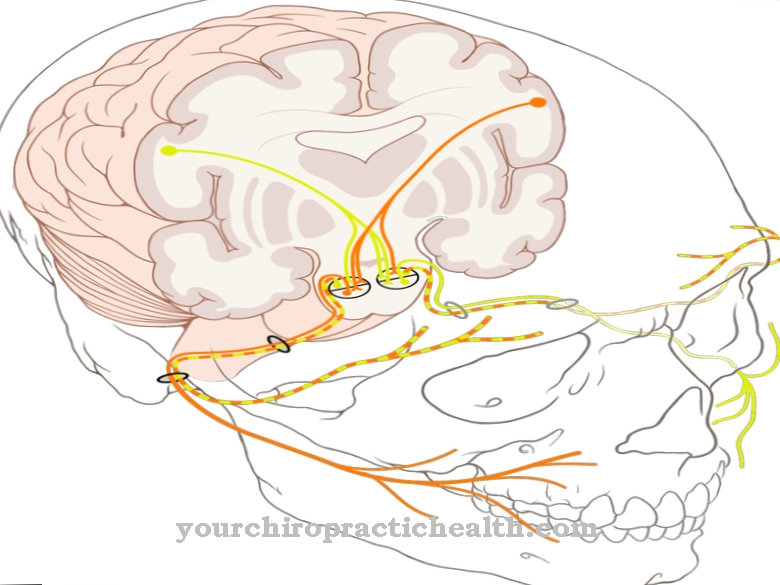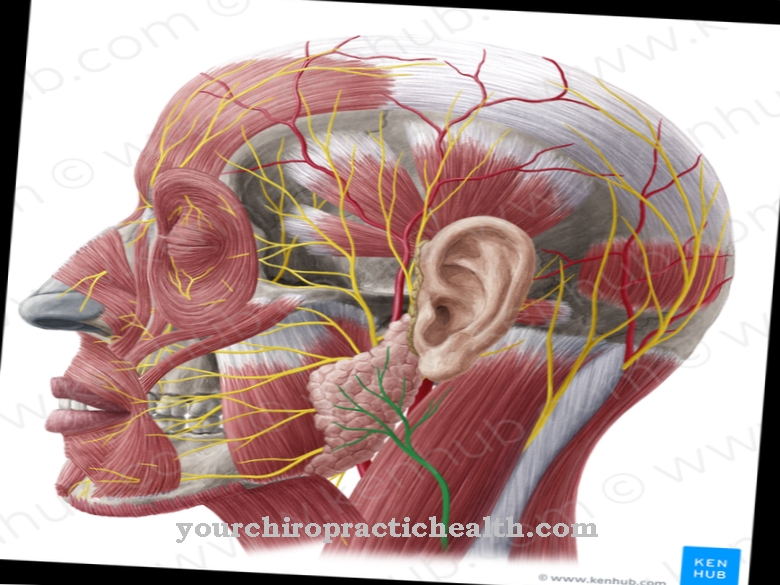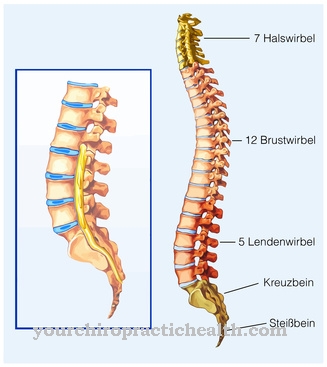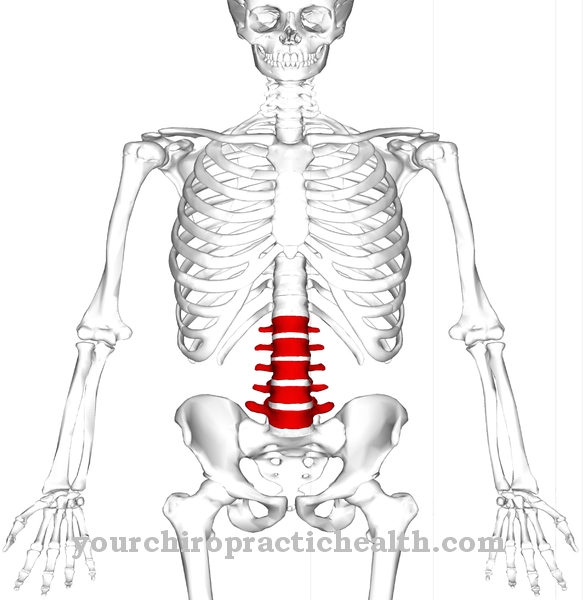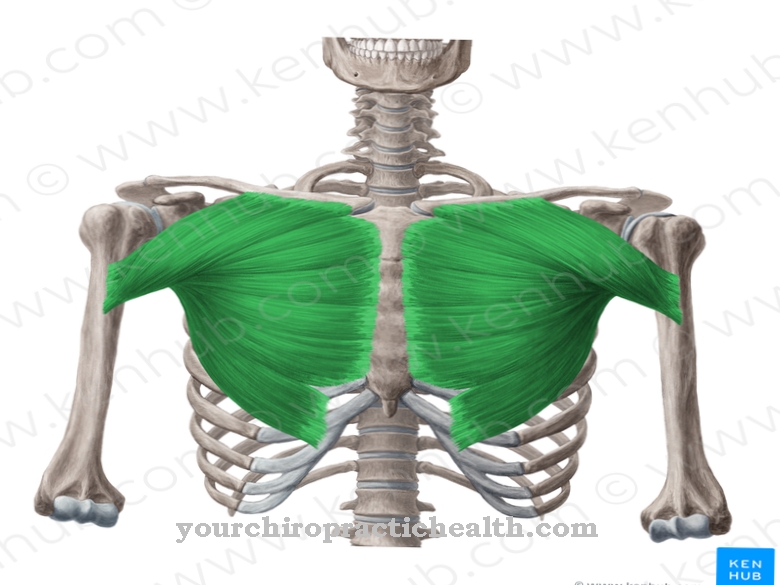The Abdominal cavity, Latin Cavitas abdominalis, refers to the cavity in the torso where the abdominal organs are located. It protects the organs and enables them to move against each other.
What is the abdominal cavity?
The abdominal cavity is one of the five cavities in the human body that protect vital organs. It is part of the abdomen, the area between the rib cage and the pelvis, which includes the abdominal cavity and the abdominal wall and organs. The abdominal cavity, the largest cavity in the body, encloses the abdominal organs, which include the stomach, large parts of the intestine, liver, gall bladder, pancreas, kidneys and spleen.
The abdominal cavity is bordered cranially, i.e. upwards, by the diaphragm, downwards or caudally by the pelvis and pelvic floor and in front and laterally by the abdominal wall. The diaphragm closes the rib cage from the abdominal cavity, whereas there is an open connection to the pelvic space.
In contrast to the above-mentioned delimitations, which consist mainly of soft tissues, which are composed of muscles, connective and fatty tissue, the spine, iliac blades and parts of the thorax of the abdominal cavity serve as bony protection.
Anatomy & structure
The abdominal cavity is subdivided into the peritoneum or peritoneal cavity, Latin Cavitas peritonealis, and the retroperitoneal space behind it, Latin Spatium retroperitoneale. The retroperitoneal space in turn merges downwards into the subperitoneal space, Latin Spatium subperitoneale.
The peritoneum cavity and the abdominal organs located in it are covered with a serous skin, the peritoneum or peritoneum. The peritoneum is a two-layer connective tissue membrane that distinguishes between the parietal peritoneum that covers the peritoneum cavity and the visceral peritoneum that covers the abdominal organs. Parietal and visceral peritoneum, also known as the parietal and visceral sheet, are connected to each other.
The peritoneal cavity contains the so-called intraperitoneal abdominal organs. These include the stomach, spleen, liver, gallbladder, small intestine and a major part of the large intestine. The retroperitoneal space contains fatty tissue and connective tissue and houses the so-called retroperitoneal abdominal organs with the kidneys, adrenal glands, the pancreas and a small part of the large intestine.
Function & tasks
The abdominal cavity serves as protection for the abdominal organs located in it. In addition to the resistance it opposes to the internal hydrostatic pressure, the abdominal cavity can also build up resistance to external pressure through a reflex or through its own will. An intact abdominal cavity creates even pressure conditions in the abdominal area.
The abdominal organs are supplied via the peritoneum, which contains numerous blood and lymph vessels and nerve tracts. The peritoneum can absorb fluid from the abdomen and release it into the blood system. The abdominal cavity is sealed airtight via the peritoneum. A layer of connective tissue of the peritoneum, the tunica subserosa, serves as a hanging strap to store and fix the intraperitoneal organs in the appropriate position.
This hanging strap is called the mesentery in the small intestine and the mesocolon in the large intestine. The organs stored in the abdominal cavity have various functions in digestion. The abdominal cavity contains a clear, viscous fluid called peritoneal fluid, or ascites, that covers the peritoneum. The peritoneal fluid is continually renewed and released from the peritoneum and absorbed again, so that in the abdominal cavity of a healthy person there is between 50 and 80 milliliters of the fluid.
The so-called tunica serosa, the second layer of the peritoneum, is responsible for releasing the peritoneal fluid. This liquid acts like a kind of lubricant, so that the organs can be moved against each other. The mobility of the organs is important, for example, during pregnancy, a full stomach after ingesting food and during digestion. The peritoneal fluid has an anti-inflammatory effect and thus also serves the immune defense.
You can find your medication here
➔ Medicines for stomach ailments and painDiseases
Abdominal pain can have a wide variety of causes and be associated with various diseases of the abdominal cavity. Tumor diseases can occur in the peritoneum, for example. So-called peritoneal carcinosis usually occurs in the form of metastases from other tumor diseases.
Peritonitis is an inflammation of the parietal peritoneum that occurs as a sequela of, for example, infections or tumors and is life-threatening if left untreated. It manifests itself in severe abdominal pain, tension in the abdominal muscles that leads to a hard abdominal wall, and can occur with a bloated stomach. If the stomach or intestinal wall is perforated, for example, bacteria can enter the abdominal cavity with the stomach or intestinal contents and cause peritonitis.
With ascites, fluid collects in the abdominal cavity. Again, this is not an independent disease, but a secondary disease. Most often, cirrhosis of the liver leads to ascites, but heart failure, carcinoma and other diseases can also be the cause. The ascites is noticeable by the bulging of the abdomen and the increase in circumference. If bleeding into the abdominal cavity, for example due to an injury or an operation, is referred to as haemascos. In addition to abdominal pain, there is [pallor]] and a poor general condition due to the loss of blood.
With a chylaskos lymph accumulates in the abdominal cavity, pneumoperitoneum is spoken of when gas accumulates. Pneumoperitoneum can result from injuries to the gastrointestinal area, among other things, but it can also be deliberately brought about for examination purposes such as a laparoscopy. Very rarely, pregnant women can develop an ectopic pregnancy in which the fertilized egg is implanted in the abdominal cavity instead of the uterus.

